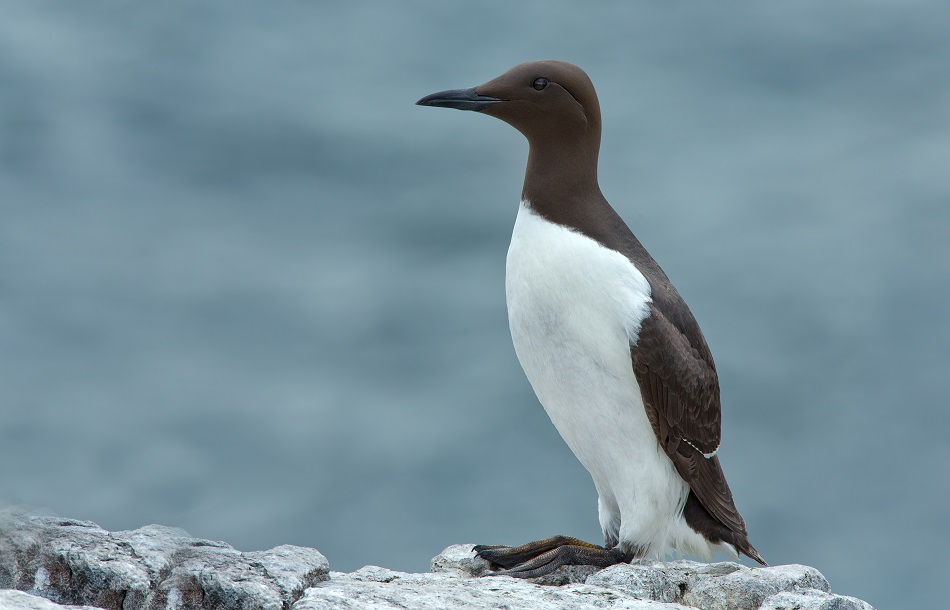Article Updated: 20th July 2021

Image Credit: Menno Schaefer/Shutterstock.com
The distinctive black and white common murre, Uria aalge, is a self-sufficient, resilient seabird that feeds on forage fish such as herring and sardines in the North Pacific. It is well-known for its ability to adapt, so when thousands of birds started washing up on the shore, scientists and environmental agencies were concerned.
In January 2016, David Irons, a retired biologist with the US Fish and Wildlife Service, counted 8,500 birds in a mile-stretch of a beach in Whittier, Alaska. It is estimated that 62,000 common murres washed up along the Pacific coastline from California to Alaska between Summer 2015 and Spring 2016, mostly in Alaska. However, it is believed close to a million birds perished as not all bodies were recovered.
The amount was unprecedented and astounding, say authors of a recent paper published in PLOS ONE which probed what happened.
Simply put, common murres - as well as tufted puffins, Cassin’s auklets, sea lions, and baleen whales – were starving. Analysis of the murre carcasses revealed nothing untoward, but many were incredibly emaciated.
Common murres are the ultimate predator, capable of diving to 200 m and able to travel anywhere, but they were dying through lack of food. Scientists considered overfishing, but this was ruled out, as was a reduction in the numbers of forage fish the common murres ate on reaching maturity.
Ultimately, the scientists concluded that the food web had been disrupted by a marine heatwave and was intensified by a ridge of high pressure on the West Coast that scientists named ‘The Blob’.
Warming Oceans
A record-breaking ocean heatwave between 2014 and 2016 triggered systemic changes throughout the marine ecosystem which caused the mass die-offs of several species. Ocean warming is increasing rapidly – last year registered the hottest ocean temperature on record – and its caused, in part, by climate change.
The common murres were dealt a double-blow – the warming water affected their food supply, and reduced the quality of the food that was available.
Phytoplankton and zooplankton at the base of the food chain were altered by the warmer waters; more mature, fatter and nutritionally rich zooplankton were replaced by southerly and offshore species that were not as nutritional, explained John Piatt, a biologist with the US Geological Survey who studied the common murre for over 40 years, and lead author on the paper.
The common murre competes for food with fish like cod and flounder, and as the water got warmer, these species increase their metabolism – an increase of a degree or two means the fish have to double their food intake. Consequently, there was more competition for food; common murres consume more than half their body weight per day, but there was no longer enough nutritionally rich food and the health of the seabird very rapidly deteriorated.
Causes
The extreme and prolonged ocean heatwave was the largest on record and was caused by several factors:
- Global warming caused the temperature of the ocean to rise, and scientists estimate this contributed a quarter of the heat in the wave.
- A further 35% of the heat was from the Pacific Decadal Oscillation, a recurring pattern of ocean-atmosphere climate variability that causes warming.
- A strong El Niño effect from 2015-6, linked to the Pacific Decadal Oscillation, caused a warming of the coast from California to Alaska.
Scientists estimate that a quarter of the additional heat was caused by ‘The Blob’. This first developed in the Fall of 2013 when a ridge of high pressure formed over the northwest coast of America and blocked airflow from the Pacific, thus trapping heat over the ocean. Its warming effect increased with the powerful El Niño.
Conclusion
In the last 35 years, marine heatwaves have doubled in frequency and will continue to become more commonplace as a result of climate change.
The mass die-off of several species during 2015 and 2016 should serve as a wake-up call; two-thirds of the common murres that died were adults, meaning the breeding population took a massive hit. Breeding colonies failed to produce any chicks for years during and after the marine heatwave.
Its highly likely that many other seabird and ocean-dwelling animals will also experience mass die-off, if not extinction, as the temperature of the oceans continues to rise due to global warming.
Sources and Further Reading
Disclaimer: The views expressed here are those of the author expressed in their private capacity and do not necessarily represent the views of AZoM.com Limited T/A AZoNetwork the owner and operator of this website. This disclaimer forms part of the Terms and conditions of use of this website.